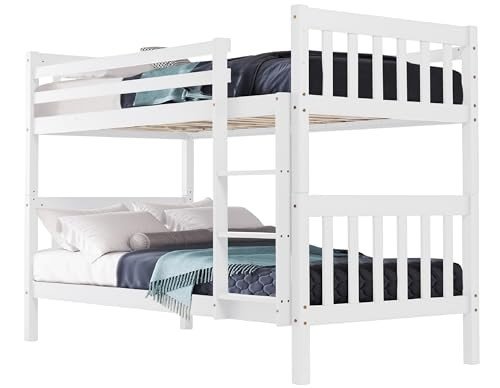Bunks: The Versatile Space-Saving Solution for Modern Living
In today's hectic world, where urban living spaces are shrinking and the demand for flexibility and usefulness is increasing, bunks have actually become a popular option. Bunks are not merely a type of bed; they represent an advanced technique to optimizing space, promoting social interaction, and offering comfortable sleeping arrangements. This post will check out the different kinds of bunks readily available, their advantages, and how they can transform both little and big living spaces.
Comprehending Bunks: What Are They?
Bunks, typically described as bunk beds, are 2 or more beds stacked on top of each other. They are created to conserve floor space, making them perfect for kids's rooms, hostels, and even adult living circumstances. Bunk beds are available in various styles and configurations, from conventional models to modern, designer interpretations.
Types of Bunks
| Kind of Bunk | Description |
|---|---|
| Twin-over-Twin | Two twin beds stacked on top of each other. Suitable for kids sharing a room. |
| Twin-over-Full | A twin bed on the top and a larger full bed on the bottom. the advantage for accommodating guests. |
| Full-over-Full | 2 full-sized beds stacked together. Perfect for older kids or adults. |
| L-Shaped Bunk Bed | Beds are set up in an L shape, enabling a corner placement and added space beneath. |
| Loft Beds | Just the top bunk exists, leaving room for a desk, couch, or storage below. |
| Triple Bunk Beds | Three beds stacked vertically, exceptional for taking full advantage of vertical space. |
Benefits of Using Bunks
- Space Efficiency: Bunks are developed to utilize vertical space, making them perfect for little bed rooms or houses where flooring space is restricted.
- Cost-Effective: Investing in a bunk bed can be more affordable than acquiring several different beds, particularly for growing households or those with frequent visitors.
- Flexible Designs: Many bunks featured add-ons, such as desks, storage drawers, or futons, enabling flexible usage of the location.
- Social Interaction: Bunk beds invite sociability amongst brother or sisters and buddies, cultivating a sense of connection.
- Innovative Use of Space: Bunk beds motivate imagination in room design, permitting spirited themes and vibrant decor that can make a bed room feel special and welcoming.
Practical Considerations
- Height Limitations: When choosing a bunk bed, it is vital to think about the height of the ceiling in the room. Step the space to make sure there is adequate clearance above the top bunk for safety and comfort.
- Weight Restrictions: Each bunk has a particular weight limitation. Moms and dads ought to assess the weight of those utilizing it, particularly when it comes to adults or heavier adolescents sharing the bed.
- Safety Features: Features such as guardrails, strong ladders, and security accreditations are vital for guaranteeing the bunk bed's safety, particularly for more youthful users.
Bunks for Various Living Situations
Household Homes
In family homes, bunks offer a useful service for brother or sisters sharing a room or accommodating pajama parties. Bunk beds can be stylishly incorporated into a child's space while supplying sufficient room for play.
Hostels and Vacation Rentals
For hostels and holiday rentals, bunk beds maximize sleeping plans without compromising convenience. Such setups use an economical way to accommodate a bigger number of guests.
College Dormitories
In college dorms, bunks help maximize the minimal square footage readily available, allowing for more space to interact socially and study.
Studio apartments
In small metropolitan apartments, lofted bunk beds develop extra space for living areas, offices, or storage, making life more manageable in compact environments.
Upkeep and Care of Bunks
Maintaining a bunk bed is important for ensuring its longevity. Here are a few suggestions:
- Regular Inspections: Check for any loose screws or bolts and tighten them as needed.
- Cleanliness: Dust and clean the bunks routinely to prevent irritants and guarantee a tidy sleeping environment.
- Bed mattress Care: Use a quality bed mattress protector to maintain health and extend the life of the mattress.
- Age Appropriateness: Upgrade to a bigger, more sturdy bunk as children grow or when the current plan no longer fulfills the requirements of its occupants.
Often Asked Questions (FAQs)
1. Are bunk beds safe for kids?
Yes, bunk beds can be safe for children if they are constructed with safety features like guardrails and a steady ladder. Constantly supervise younger children when they are using bunk beds.
2. What age is appropriate for a child to sleep on the top bunk?
Many producers advise that kids under the age of 6 should not sleep on the upper bunk due to safety concerns.
3. Just how much weight can bunk beds typically hold?
Weight capabilities differ based upon the style and products but generally vary from 200 to 400 pounds. Always examine the maker's standards.
4. Can bunk beds be separated into 2 single beds?
Lots of bunk beds are designed to be convertible, enabling them to be separated into 2 private beds. It's necessary to check the product specifications before acquiring.
5. What sort of bed mattress is best for a bunk bed?
A medium-firm mattress is typically advised as it provides sufficient assistance without being too heavy or soft, which can present security issues.
Bunks are more than simply beds. They are ingenious space-saving options that deal with the needs of modern-day living. With different designs offered, they offer comfort and performance for households, guests, and individuals alike. By prioritizing safety and maintenance, owners can ensure that their bunk beds become a cherished part of their living spaces for several years to come. Whether for lively kids or accommodating guests, bunk beds provide a stylish and useful option to the obstacle of minimal space.

